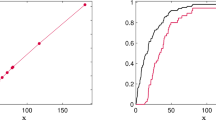Abstract
This paper considers the demand for insurance in a model with uncertain indemnity. Uncertain indemnity tends to increase the demand for insurance for precautionary reasons, but it also tends to decrease the demand due to the risk created by indemnity uncertainty. When the coefficient of relative prudence is not too large, uncertain indemnity reduces the demand for insurance and partial coverage is optimal even at actuarially fair premiums. In addition, insurance may be an inferior good or a normal good, depending on the behavior of absolute risk aversion and the magnitude of the coefficient of relative risk aversion.
Similar content being viewed by others
References
Browning M., Lusardi A. (1996) Household saving: Micro theories and micro facts. Journal of Economic Literature 34: 1797–1855
Choi G., Kim I., Snow A. (2001) Comparative statics predictions for changes in uncertainty in the portfolio and savings problem. Bulletin of Economic Research 53: 61–72
Cook P. J., Graham D. A. (1977) The demand for insurance and protection: The case of irreplaceable commodities. Quarterly Journal of Economics 91: 143–156
Crocker K., Tennyson S. (2002) Insurance fraud and optimal claims settlement strategies. Journal of Law and Economics 45: 469–507
Deck C., Schlesinger H. (2010) Exploring higher order risk effects. Review of Economic Studies 77: 1403–1420
Doherty N. A., Schlesinger H. (1983) Optimal insurance in incomplete markets. Journal of Political Economy 91: 1045–1054
Doherty N. A., Schlesinger H. (1990) Rational insurance purchasing: Consideration of contract nonperformance. Quarterly Journal of Economics 105: 243–253
Ebert, S., & Wiesen, D. (2010). Joint measurement of risk aversion, prudence, and temperance. Discussion Paper, No. 20/2010, University of Bonn, Bonn.
Eisenhauer J. (2000) Estimating prudence. Eastern Economic Journal 26: 379–392
Fei W., Schlesinger H. (2008) Precautionary insurance demand with state-dependent background risk. Journal of Risk and Insurance 75: 1–16
Gollier C. (2001) Economics of risk and time. MIT Press, Cambridge
Guiso L., Jappelli T., Terlizzese D. (1992) Earnings uncertainty and precautionary saving. Journal of Monetary Economics 30: 307–338
Hadar J., Seo T. K. (1990) The effects of of shifts in a return distribution on optimal portfolios. International Economic Review 31: 721–736
Kerr D. (2006) Understanding basis risk in insurance contracts. Risk Management and Insurance Review 9: 37–51
Kimball M. (1990) Precautionary savings in the small and in the large. Econometrica 58: 53–73
Lee K. (2007) Wealth, income, and optimal insurance. Journal of Risk and Insurance 74: 175–184
Luechinger S., Raschky P. (2009) Valuing flood disasters using the life satisfaction approach. Journal of Public Economics 93: 620–633
Lusardi A. (1998) On the importance of the precautionary saving motive. American Economic Review Papers and Proceedings 88: 449–453
Mitchell D. W. (1994) Relative risk aversion with Arrow-Debreu securities. International Economic Review 35: 257–258
Mossin J. (1968) Aspects of rational insurance purchasing. Journal of Political Economy 76: 552–568
Noussair, C. N., Trautmann, S. T., & van de Kuilen, G. (2011). Higher order risk attitudes, demographics, and financial decisions. Unpublished Manuscript, Tilburg University, Tilburg.
Picard P. (1996) Auditing claims in the insurance market with fraud: The credibility issue. Journal of Public Economics 63: 27–56
Rey B. (2003) A note on optimal insurance in the presence of a nonpecuniary background risk. Theory and Decision 54: 73–83
Schlesinger H. (2000). The theory of insurance demand. In G. Dionne (Ed.), Handbook of insurance (pp. 131–151). Boston: Kluwer Academic Publishers
Smith V. L. (1968) Optimal insurance coverage. Journal of Political Economy 76: 68–77
Sydnor, J. (2010). (Over)insuring modest risks. American Economic Journal: Applied Economics, 2, 177–199.
Author information
Authors and Affiliations
Corresponding author
Rights and permissions
About this article
Cite this article
Lee, K. Uncertain indemnity and the demand for insurance. Theory Decis 73, 249–265 (2012). https://doi.org/10.1007/s11238-012-9316-5
Published:
Issue Date:
DOI: https://doi.org/10.1007/s11238-012-9316-5




